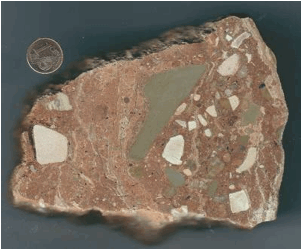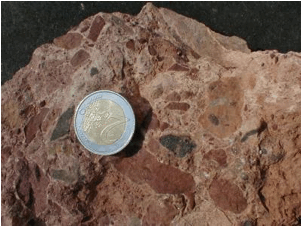Basal suevite breccia in the Rubielos de la Cérida impact basin
The name “basal breccia”, originally introduced for rocks in the Azuara impact structure (see breccias and azuara_suevite), refers to the fact that this peculiar breccia is regularly found at the base of the post-impact (and post-Alpidic), tectonically undisturbed Upper Tertiary. The up to 20 m thick horizontally bedded breccia layer is always unconformably overlying the folded rocks (Fig. 1) and at the contacts more or less meshed with them without any re-working or soil formation. Paleozoic and Mesozoic rocks contribute to the sharp-edged (sometimes subrounded) clasts and minute splinters in an extremely hard and exceptionally cemented carbonate matrix that often displays distinct flow texture.
Clasts that are themselves breccias (breccias-within-breccias) are abundant. Frequently, limestone and dolomite clasts show a skeletal and vesicular texture, sometimes to the extent that only the rim of a clast remains and the hollow may contain a residual white powder. High-temperature decarbonization, the formation of carbonate melt and subsequent recombination are the probable causes. From X-ray fluorescence and X-ray diffraction analyses and thin-section inspection, Mayer (1991) infers an SiO2 amorphous phase (up to about 10%) contributing to the matrix. This phase is assumed to be finely dispersed glass. In a few cases, glass particles in the basal breccia can be observed by the optical microscope.
 Fig. 1. Basal breccia unconformably overlying steeply dipping Jurassic limestones. Rubielos de la Cérida central-uplift chain, Sierra Palomera.
Fig. 1. Basal breccia unconformably overlying steeply dipping Jurassic limestones. Rubielos de la Cérida central-uplift chain, Sierra Palomera.
Shock-metamorphic effects are frequently observed in minerals from silicate fragments. Most significant is the abundant occurrence of diaplectic quartz in the basal breccia (Mayer, 1991). The formation of diaplectic quartz requires shock pressures in excess of 15 GPa (= 150 kbar) (Bunch et al., 1968). Planar deformation features (PDFs) are rare, but multiple sets of planar fractures (PFs, cleavage) in quartz, microtwinning in calcite and strong kink banding in mica indicate moderate shock metamorphism. According to the current classification and nomenclature of impact rocks (IUGS Subcommission on the Systematics of Metamorphic Rocks, Study Group for Impactites), this polymictic basal breccia containing shocked clasts and melt, is termed a suevite or suevite breccia.
As in most cases the matrix of the basal breccia has a dominantly carbonate composition, a crystallization from a carbonate melt must be taken into consideration. In this case, and according to the IUGS nomenclature, the basal breccia would better be termed an impact melt rock. A clear distinction, however, is difficult, and a coexistence of matrix derived from a melt and from an accumulation of clastic material cannot be excluded.
A breccia having a comparable facies and the same stratigraphic position is very abundant also in the Rubielos de Cérida impact basin. It is found in the central-uplift chain (Figs. 1, 3), in the rim regions (Fig. 2), and in between where Mesozoic rocks emerge from the Cenozoic and Quaternary. The ubiquitous occurrence of this basal suevite breccia stratigraphically uniformly exposed from the northern part of the Azuara structure to the southern part of the Rubielos de la Cérida elongated impact basin over a distance of roughly 120 km, are strong clues to establishing a multiple impact by a disrupted asteroid or comet (see https://www.impact-structures.com/Archiv/wkarchiv13.html).
Regional geologists refusing the impact origin of Azuara and Rubielos de la Cérida (M. Aurell, E. Díaz-Martínez, A. L. Cortés, and others) consider the basal breccia to be either a conglomerate, lacustrine sediments, or calcrete (caliche). With respect to the images shown below, the shock effects, and the stratigraphically uniform deposition over 120 km length, the reader may decide whether he/she agrees to their interpretation.
Suevitic basal breccia in outcrop
 Fig. 2. Basal breccia in sharp contact over Cretaceous Utrillas Fm. Near Fuentes Calientes, eastern basin region.
Fig. 2. Basal breccia in sharp contact over Cretaceous Utrillas Fm. Near Fuentes Calientes, eastern basin region.
 Fig. 3. Contact basal breccia over Utrillas sandstone; near Fuentes Calientes.
Fig. 3. Contact basal breccia over Utrillas sandstone; near Fuentes Calientes.
 Fig. 4. The suevitic basal breccia from Figs. 2, 3 in close-up. The strongly corroded clasts reflect intense decarbonization and/or carbonate melting. The decomposition obviously confined to the interior of the clasts is not completely understood thus far, but we suggest two possibilities that must not exclude one another. The clasts belonged to Lower Tertiary conglomerates in the target, and they experienced a shock concentration in the cobbles’ interior by shock-wave reverberation and focusing effects. The other possibility is shock heating of the cobbles and a rapid external cooling upon ejection, only allowing the interior to be decarbonized and melted. Similarly corroded clasts are frequently observed in Azuara and Rubielos de la Cérida impact deposits.
Fig. 4. The suevitic basal breccia from Figs. 2, 3 in close-up. The strongly corroded clasts reflect intense decarbonization and/or carbonate melting. The decomposition obviously confined to the interior of the clasts is not completely understood thus far, but we suggest two possibilities that must not exclude one another. The clasts belonged to Lower Tertiary conglomerates in the target, and they experienced a shock concentration in the cobbles’ interior by shock-wave reverberation and focusing effects. The other possibility is shock heating of the cobbles and a rapid external cooling upon ejection, only allowing the interior to be decarbonized and melted. Similarly corroded clasts are frequently observed in Azuara and Rubielos de la Cérida impact deposits.
 Fig. 2. Basal breccia (reddish-brownish color) unconformably overlying strongly fractured Muschelkalk limestones. Southeastern rim region, between El Pobo and Corbalán.
Fig. 2. Basal breccia (reddish-brownish color) unconformably overlying strongly fractured Muschelkalk limestones. Southeastern rim region, between El Pobo and Corbalán.
 Fig. 3. Basal breccia (reddish color) overlying mega-brecciated Muschelkalk limestones. Central-uplift chain, northeast of Caudé.
Fig. 3. Basal breccia (reddish color) overlying mega-brecciated Muschelkalk limestones. Central-uplift chain, northeast of Caudé.
 Fig. 4. The suevitic basal breccia in close-up. Note the large clasts exhibiting distinct flow texture. Central-uplift chain, northeast of Caudé.
Fig. 4. The suevitic basal breccia in close-up. Note the large clasts exhibiting distinct flow texture. Central-uplift chain, northeast of Caudé.
 Fig. 5. Breccia generations in the basal breccia; see below hammer. Central-uplift chain, northeast of Caudé.
Fig. 5. Breccia generations in the basal breccia; see below hammer. Central-uplift chain, northeast of Caudé.
 Fig. 6. Breccia pocket in the basal breccia. Central-uplift chain, northeast of Caudé.
Fig. 6. Breccia pocket in the basal breccia. Central-uplift chain, northeast of Caudé.
Suevitic basal breccia sawed samples from various locations
 Fig. 7. Basal breccia from the southern central-uplift chain near Celadas.
Fig. 7. Basal breccia from the southern central-uplift chain near Celadas.
 Fig. 8. Basal breccia from the eastern central-uplift chain near Camañas. Note flow texture and the larger clasts adjusted to the flow. The reddish color of many limestone fragments probably results from enhanced temperatures.
Fig. 8. Basal breccia from the eastern central-uplift chain near Camañas. Note flow texture and the larger clasts adjusted to the flow. The reddish color of many limestone fragments probably results from enhanced temperatures.
 Fig. 9. Basal breccia from the eastern central-uplift chain between Camañas and Alfambra. Again, the reddish color of many limestone fragments probably results from enhanced temperatures. Sample courtesy of P. Bockstaller.
Fig. 9. Basal breccia from the eastern central-uplift chain between Camañas and Alfambra. Again, the reddish color of many limestone fragments probably results from enhanced temperatures. Sample courtesy of P. Bockstaller.
 Fig. 10. Basal breccia from the central-uplift chain southwest of Aguatón. Note the dikelets of matrix material cutting up several clasts.
Fig. 10. Basal breccia from the central-uplift chain southwest of Aguatón. Note the dikelets of matrix material cutting up several clasts.
 Fig. 11. Basal breccia from the central-uplift chain near Celadas. The white material is assumed to be relics of carbonate melt.
Fig. 11. Basal breccia from the central-uplift chain near Celadas. The white material is assumed to be relics of carbonate melt.
 Fig. 12. Basal breccia from the western basin north-northwest of Villafranca del Campo. Note the flow texture and the multiple breccia generations. With regard to the term “breccia”, the well-rounded clasts must not confuse. Rounded clasts is a well-known phenomenon in impact breccias. Internal rotations under high pressure (impact “conglomeratization”, see https://www.impact-structures.com/impact-france/the-rochechouart-impact-rocks/ ) and marginal decarbonization/melting of carbonate fragments may be considered to be the cause.
Fig. 12. Basal breccia from the western basin north-northwest of Villafranca del Campo. Note the flow texture and the multiple breccia generations. With regard to the term “breccia”, the well-rounded clasts must not confuse. Rounded clasts is a well-known phenomenon in impact breccias. Internal rotations under high pressure (impact “conglomeratization”, see https://www.impact-structures.com/impact-france/the-rochechouart-impact-rocks/ ) and marginal decarbonization/melting of carbonate fragments may be considered to be the cause.
 Figs. 13-16. More basal breccias from the western basin north-northwest of Villafranca del Campo: a multicolored mixture of Buntsandstein, Muschelkalk, Keuper (and ?Jurassic) fragments and a significant contribution of red Buntsandstein material to the matrix.
Figs. 13-16. More basal breccias from the western basin north-northwest of Villafranca del Campo: a multicolored mixture of Buntsandstein, Muschelkalk, Keuper (and ?Jurassic) fragments and a significant contribution of red Buntsandstein material to the matrix.
 Fig. 17. Matrix-rich basal breccia.
Fig. 17. Matrix-rich basal breccia.
 Fig. 18. Note the heavily corroded, vesicular limestone clast probably having originated from strong heating.
Fig. 18. Note the heavily corroded, vesicular limestone clast probably having originated from strong heating.
 Fig. 19. Distinct flow texture in the basal breccia.
Fig. 19. Distinct flow texture in the basal breccia.
 Fig. 20. Basal breccia from the eastern basin between Visiedo and Perales de Alfambra.
Fig. 20. Basal breccia from the eastern basin between Visiedo and Perales de Alfambra.
 Fig. 21. Basal breccia with distinct flow-texture. From the southwestern central-uplift chain between Villarquemado and Celadas.
Fig. 21. Basal breccia with distinct flow-texture. From the southwestern central-uplift chain between Villarquemado and Celadas.
 Fig. 22. Basal breccia from the southeastern rim region, southwest of El Pobo. Breccia-within-breccia, to the right of the coin.
Fig. 22. Basal breccia from the southeastern rim region, southwest of El Pobo. Breccia-within-breccia, to the right of the coin.
 Fig. 23. More basal breccia from the southeastern rim region, southwest of El Pobo. Few Buntsandstein and Muschelkalk clasts in a matrix with a high contribution of Buntsandstein material.
Fig. 23. More basal breccia from the southeastern rim region, southwest of El Pobo. Few Buntsandstein and Muschelkalk clasts in a matrix with a high contribution of Buntsandstein material.
 Fig. 24. More basal breccia from the southeastern rim region, southwest of El Pobo exhibiting predominantly Buntsandstein components. Note the dikelets of (?) former carbonate melt cutting up the larger sandstone clast (in close-up below).
Fig. 24. More basal breccia from the southeastern rim region, southwest of El Pobo exhibiting predominantly Buntsandstein components. Note the dikelets of (?) former carbonate melt cutting up the larger sandstone clast (in close-up below).
 Fig. 25. Close-up of the cut in Fig. 24. Note the flow-within-flow texture of the dikelets.
Fig. 25. Close-up of the cut in Fig. 24. Note the flow-within-flow texture of the dikelets.






































































